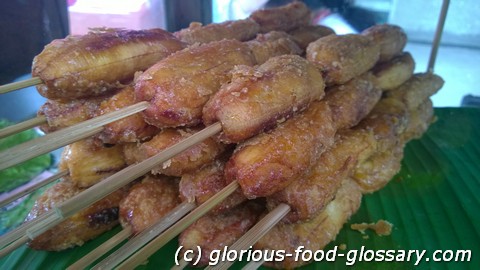Deutsch: Bananen-Q / Español: Plátano Frito / Português: Banana Assada / Français: Banane Caramelisée / Italiano: Banana Fritta /
In the food context, "Banana Cue" (sometimes written as "Banana Q") is a popular street food snack in the Philippines. It consists of deep-fried bananas, typically of the Saba variety, which is a type of cooking banana that's firmer and starchier than the more widely known dessert bananas. These bananas are skewered on bamboo sticks, coated in caramelized brown sugar, and then deep-fried until the sugar coating becomes crisp and glossy. The result is a sweet, sticky, and slightly crunchy treat that combines the natural flavor of the banana with a caramel coating.
Preparation:
The preparation of Banana Cue is relatively simple and involves the following steps:
- Skewering: The Saba bananas are peeled and skewered onto bamboo sticks. Sometimes, they are cut in half for easier consumption, but they can also be left whole.
- Caramelization: The skewered bananas are then rolled in brown sugar.
- Deep-Frying: The sugar-coated bananas are deep-fried in hot oil. As they fry, the brown sugar melts and caramelizes, forming a shiny coating around the bananas.
- Serving: The Banana Cue is typically served hot and eaten as a handheld snack.
Cultural Significance:
Banana Cue is a beloved snack in the Philippines and can be found being sold by street vendors, especially in the afternoon as a sweet treat or merienda (afternoon snack). Its popularity stems from its delicious taste, affordability, and the convenience of being able to eat it on the go. Along with other skewered street foods like "Camote Cue" (sweet potato) and "Turon" (banana spring rolls), Banana Cue is a staple in Filipino snack culture.
Nutritional Aspects:
While bananas themselves are nutritious, providing dietary fiber, vitamins, and minerals, the deep-frying process and addition of sugar in Banana Cue make it a high-calorie treat that's best enjoyed in moderation.
Summary
Banana Cue is a testament to the creativity and simplicity of Filipino cuisine, offering a unique way to enjoy bananas. This street food delicacy highlights the versatility of the Saba banana and is a cherished part of the Philippines' rich culinary tradition.
--
Referred Picture:

Related Articles to the term 'Banana Cue' | |
| 'Kelewele' | ■■■■■■■■■■ |
| Kelewele refers to one of Ghana\'s food and a popular type of street food made of spicy and sweetish . . . Read More | |
| 'Pritong Kamote' | ■■■■■■■■■■ |
| Pritong Kamote refers to fried sweet potatoes in Filipino cuisine, a popular snack or side dish that . . . Read More | |
| 'Turon' | ■■■■■■■■■■ |
| Turon is a Filipino food of fried spring roll, either meat, vegetable, usually banana. . . . . . . Read More | |
| 'Buchi' | ■■■■■■■■■■ |
| In the food context, \'Buchi\' is a popular Filipino dessert made from glutinous rice flour filled with . . . Read More | |
| 'Maruya' | ■■■■■■■■■■ |
| Maruya is a traditional Filipino snack made from bananas, typically Saba bananas, which are battered . . . Read More | |
| 'Banana que' | ■■■■■■■■■■ |
| Banana que is a Filipino dessert or snack that refers to saging na saba (a variety of cooking banana) . . . Read More | |
| 'Inkalti' | ■■■■■■■■■ |
| Inkalti refers to an Ilocano\'s molasses-based dessert sweet snack made of rice balls which are dipped . . . Read More | |
| 'Kaki-Lima' | ■■■■■■■■■ |
| Kaki-Lima literally means \'five feet\' in Indonesia refers to a roving street vendors selling assorted . . . Read More | |
| 'Amagwinya' | ■■■■■■■■■ |
| Amagwinya also known as Vetkoek refers to a popular traditional Zulu food which is flour mixture with . . . Read More | |
| 'Proven' | ■■■■■■■■■ |
| Proven also spelled Proben is one of the Street food in the Philippines made of the Proventriculus of . . . Read More | |
